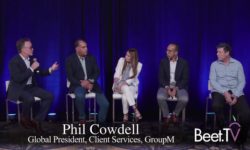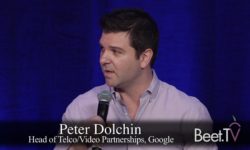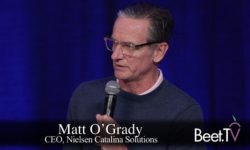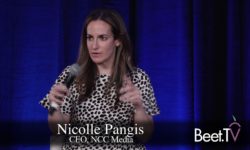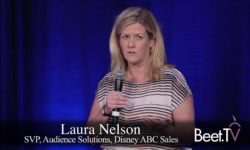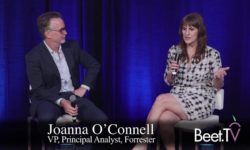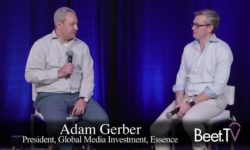SAN JUAN — If you listen to the tech crowd and if you look at some of the consumer behavior, TV is “dying”.
But, if that is the case, how do you explain Netflix?
Many executives in the industry have long since moved on from using “TV” to describe the box in the living room connected to an antenna, with many choosing the describe all moving-picture content, including “TV”, as “video”, whatever device it is delivered on.
But what is the current state of “television”, does it matter and what’s in a name?
A Beet Retreat panel convened by Beet.TV discussed the issue in Puerto Rico…
TV is the same – and different
Television is becoming something very different, with hugely different capabilities. But, for both viewers and advertisers alike, there has been no wholesale recalibration of the enduring nature of “TV”…
Julie DeTraglia, Head of Research, Hulu:
“I mean, Hulu is television. If we don’t define it as television, I don’t know what else we’d call it. Increasingly, especially as you get to younger generations, they define streaming as television. Older generations slightly less so.
“We do have advertisers that consider us in two different ways. You have sort of more traditional reach-and-frequency linear buyers who look at Hulu as a reach extension, as a way to brand their products, as a branding platform. And then increasingly, we have all of these direct-to-consumer advertisers … who treat television a little bit differently, who want the data that they’re accustomed to getting in digital.”
But TV is fragmenting
Viewers may still have a unified sense of what TV is – but that doesn’t mean that, for broadcasters and advertisers, the medium isn’t nevertheless splintering in to umpteen different challenges…
Neil Smith, GM, FreeWheel Markets:
“It’s clear from our data that the consumer defines OTT as television. It’s the fastest growing platform, it kind of enfuels dataset, and it’s also the largest.
Now the challenge, I think there are a couple that we see with publishers. One is it’s very fragmented. We look at kind of OTT – there are a couple different buckets of devices that we include in that. So there’s kind of plug-in devices like Roku or an Apple TV or an Amazon Fire. There are gaming consoles. There are (also) smart TVs.”
Advertisers want ‘TV’, but like digital
From the advertiser perspective, the panel heard how advertisers want all of this complexity simplified so they can execute video- or TV-like ad buys across all the screens. But there is a tension – they want TV-like simplicity, but they want far more of the benefits of digital channels…
Anupam Gupta, Chief Product Officer, 4C Insights
“What they’re looking to do is buy a single audience across different platforms – plan, and buy, and get the outcomes that they need. In each of those cases, there is friction. Using first party data, third party data, all that is possible, but there’s friction like the matching process that the previous panel talked about.
“The number of days it takes (is significant). By contrast, campaigns can be live on digital platforms in literally an hour, (or) a day. So if it takes two weeks, that there is friction.”
Addressable TV hard to scale
The panel heard from one tech vendor that was early in to helping brands benefit from digital targeting of TV viewers. He said that addressable TV is powerful, but hard to expand…
Mike Baker, CEO, dataxu:
“We started experimenting with addressable TV for Ford. (They asked), ‘Could you literally show us the incremental cost of selling an F150 using highly targeted addressable TV?’ We said, ‘Sure, we do data science innovation’.
“We did the campaign, and it was like $767. The VP of sales was like, ‘Yippee, this is great’. And then I want to scale this, and it just ground to a halt. And we were sort of snake-bitten by that, because what you could show is the promise of using all this data and analytics really could ring the bell for a major marketer and get them very enthused. But it just couldn’t scale.
“So we sort of retrenched a little bit and said, what is – back to the friction point – how could you have a more digital like workflow? And what would it require?”
But beware excess scale
But a panel member also echoed a view heard elsewhere during Beet Retreat, that the extent of available content against which to sell ads has a profound impact on how ads are sold there…
Neil Smith, GM, FreeWheel Markets:
“We’re potentially falling into the same trap we did with digital video on other platforms – we’re kind of sacrificing the quality of the content and that ultimate TV experience to go get scale in places that’s kind of a different-quality-of-content, different-context, probably different-value-proposition to marketers.”
Measurement needs metadata
Advertisers want to be able to straightforwardly understand who is viewing content and ads, no matter what the device. But, in a world of proliferating platforms, each with their own commitments and approaches, that can be difficult…
Carol Hinnant, EVP, National TV, Comscore:
“It’s a very difficult environment to try to pull all of that together. What we’re working on cross-platform is really taking that linear television approach and bringing in all the various (other) platforms and lining it up with the linear television.
“Metadata behind all of this is what is absolutely critical. And that has to be solved. Because there is no group today that is good at their metadata.”
This video was produced in San Juan, Puerto Rico at the Beet.TV executive retreat. Please find more videos from the series on this page. The Beet Retreat was presented by NCC along with Amobee, Dish Media, Oath and Google.







